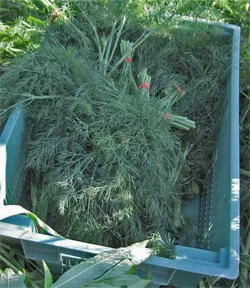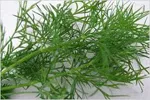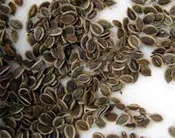Harvesting Dill
If you allow dill to flower, leaf production will cease; when it sets seed, the plant dies. Therefore, plan your dill harvest based on whether you want to use fresh dill in recipes, preserve leaves (dill weed) and/or preserve seed.

Dill weed:
Characteristic aroma is an indicator of fresh herb quality. You can use dill weed once the fern-like leaves develop (about 8 weeks); cut them next to the stem. However, peak quality is just as flower heads open. Culinary quality of dill declines after cutting; if possible, cut just what you need when you need it.
Gently harvest your herbs; use pruning scissors. This is especially important if storing dill weed in your refrigerator or if you are going to freeze, heat or air dry dill weed. Damage to the leaves at harvest can lead to discoloration and increased susceptibility to decay.
Dill seeds:
After flowering, allow the seed heads to dry on the plant. The entire seed head can be cut when the seeds are a pale brown.
Preserving Dill

Preserving fresh dill weed:
According to UC/Davis’ Postharvest Technology Research and Information Center, fresh dill stored at 32ºF has an expected shelf life of 3 weeks; whereas at 41 ºF, the maximum shelf life of dill is 2 weeks.
However, depending on water loss, the herb may have a shelf life as short as 1 week. Freeze-damage can occur on dill stored below 31ºF and will appear as darkened translucent or water-soaked areas which will deteriorate quickly after thawing. Do not spray water on your herbs like the grocery store; this may encourage bacterial rot.

Dried dill weed and seeds:
- Pick for leaf harvest just before flowers open. This is when the leaves contain the highest concentration of oils.
- The day before harvesting leaves, spray them with water so that they will be clean and dry the day of harvest.
- The day of leaf harvest, pick dill in the early morning or place stems in water for two hours.
- Strip damaged lower leaves and remove any flower heads (unless you are harvesting seeds as described below).
- Use kitchen string or a rubber band to loosely combine the stems into small bundles. Do not bunch herbs tightly or it may encourage mold as they are drying.
- Hang the bunches upside down in a dark warm dry place with good air circulation. This preserves the essential oils, which, in turn, preserves the flavor.
- The herbs are ready when all of the moisture is gone and they are crisp enough to crumble (one to two weeks in most cases).
- As an alternative to hanging the herbs, herbs may be dried in the oven. Set the oven at the lowest temperature possible (ideally 110ºF or less). Spread the herbs out on a baking sheet…don’t crowd them. With the oven door partly open, monitor the herbs closely. Herbs are ready when they are crisp enough to crumble. If you use a dehydrator or solar dryer, follow the manufacturer’s directions.
- If you are gathering seeds from flower heads, use the hanging method above and loosely secure a paper bag over the flower heads to collect the seed before hanging, or place a clean cloth under the drying herbs. Note: Some people loosely cover all drying herbs with paper bags in order to catch any falling leaves and/or to protect the herbs if they are being dried in a dusty attic or garage.
- Seeds, whole leaves removed from the stem or crushed leaves should be stored in airtight glass jars (preferably in brown glass) and kept in a cool, dry cupboard out of the light.
- Inspect jarred herbs after the first week. If there is condensation in the jar, remove the leaves for further drying.
If you found this information helpful, we invite you to sign up for our Newsletter
Get more high-quality science-based gardening information for your Sonoma County garden in our monthly Newsletter. Our local UC trained Master Gardener volunteers write articles, produce YouTube videos and hold free gardening events - all focused on the needs of the Sonoma County home gardener.
Click here to sign up for our Newsletter
Our Newsletter is free and we will never share your email address.
Updated July 2025


